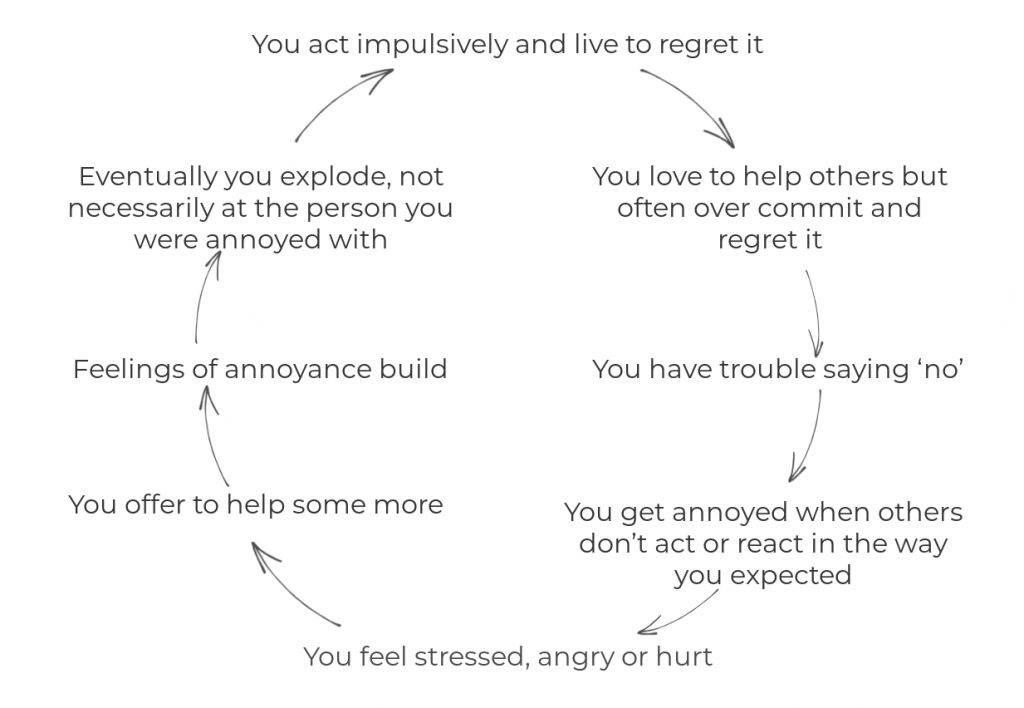The cycle of the person who does not value themself often follows a common
path. It goes like this:

Then you repeat the cycle over and over again
If you find yourself caught on this hamster wheel the good news is that it is possible to get off.
Boundaries are the key to building healthier relationships and creating a happier life. If this cycle matches your experience it’s likely your boundaries are very weak or even non-existent.
Setting and maintaining boundaries is a skill you can learn which will break this cycle right from the start. But it’s one which many people are unsure of or afraid to begin.
Set Boundaries
There are two parts essential to setting effective boundaries. The first is creating the boundary. This is about knowing and understanding your limits. It’s impossible to set boundaries if you don’t know exactly where you stand. It’s equally important to know what you are willing to accept and tolerate, and what causes you to feel stressed. Knowing this helps identify what your limit is and where you need to create the boundary.
Feelings of resentment or discomfort are cues to us that we have let our boundaries slide. They often stem from a feeling of not being appreciated, or of being taken advantage of. When they show up we need to firm up our boundaries. In the diagram above all the stages from “You get annoyed when others don’t act or react in the way you expected” onward are red flags.
Setting boundaries can be a real challenge, especially if you’re not used to it, due to feeling guilt, doubt or fear of what the other’s response may be. You may even feel selfish for wanting to create the boundary at all. But healthy boundaries are an indication of self-respect so they’re essential for our happiness.
Healthy boundaries are an indication of self-respect so they’re
essential for our happiness
Maintain Boundaries
Once you really notice your feelings and can decide exactly where your boundaries need to sit, it’s essential to work out ahead how you will respond when the situation arises. This can be extra difficult if you regularly take on the role of caretaker of others and you ignore your own needs. But becoming proficient at something new and unfamiliar is simply a matter of practice and setting boundaries is no exception.
It’s essential to make self-care your priority here. Whenever you notice the feeling that is your cue that a boundary is required, you need to put yourself first and honour your needs rather than continue to progress through the cycle. Attending to your own needs in a loving, caring way brings you peace, energy and more presence. When you do this for yourself you are better able to be there for others.
How To Establish Your Boundaries
It’s one thing to create a boundary but another to be assertive enough to maintain it if you’re not used to doing this. Again, this is something you can achieve with practice.
I recommend my clients always start small. Identify something that irritates you but which taking a stand over, won’t cause a major confrontation or upset. And then I have them practice what they will say to the other person, over and over until they are comfortable with it.
I also get them to devise a sentence they can repeat to deflect other’s objections. Something such as “It would mean a lot to me to make this change” is effective because it doesn’t open the door to argument and cannot be disclaimed by the other person.
Starting small gives you practice in asserting yourself in a way that honours your needs and gets you off the cycle. It allows you to build on your success and over time take on more challenging issues. And it gives you practice setting effective boundaries.
Setting and maintaining boundaries is a skill you can master using
courage and practice.


